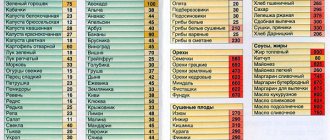Formula for calculating calories
It is impossible to choose the right diet for weight loss or, conversely, for muscle growth, without first calculating the daily calorie intake. It is from this step that the formation of a diet begins in terms of basic nutrients, that is, fats, carbohydrates and proteins.
In the literature you can find two basic formulas that help determine the rate of calorie intake. These are the formulas used in special fitness bracelets, exercise machines and smartphone applications. However, all the formulas used have huge errors, which, as a rule, are never mentioned anywhere.
Daily calorie intake for women and men. Let's count!
Proteins, fats and carbohydrates in the diet
In the process of improving your body, it is important not only to correctly calculate calories for weight loss or weight gain, but also to balance your diet.
Protein is the most important building component in the body; it is found in abundance in meat, seafood, dairy and fermented milk products, eggs, cereals and legumes. Animal protein is preferable for our body, as it is considered complete due to its large set of essential amino acids.
The protein intake rate is from 0.8 to 1.2 grams per kilogram of weight.
Fats have a scary name, but they are responsible for beauty. For the way your hair, skin and nails look and how hormonal synthesis occurs. But you should only consume healthy fats (fish, avocado, nuts, natural oils) and do not abuse them. Trans fats (fast food, chips, popcorn) should be strictly excluded from the daily diet and consumed extremely rarely. The daily intake of fat is 1 g per kg of weight.
Carbohydrates are energy. Simple carbohydrates (sweets, flour products made from wheat flour) should be reduced in the diet and complex carbohydrates (porridge, cereals, flour products made from whole grain, rice, oatmeal, soy, coconut, buckwheat flour) should be consumed. Complex carbohydrates keep you full for a long time, as they are digested much longer than simple ones. The daily amount of carbohydrates should not be lower than 100-110 grams.
You can calculate the number of calories in foods by knowing only the amount of BZHU, since each of them has its own calorie content. 1 gram of protein or carbohydrates contains 4 kcal, and 1 gram of fat contains 9 kcal. Sometimes it is better not to be lazy and double-check the number of calories indicated on the product label in this way. Often the indicators will differ, unfortunately, for the worse. Many manufacturers deliberately underestimate the number of calories in order to expand their circle of customers.
Definition of “calorie”
First of all, it is worth defining what a calorie is. This word comes from the Latin term for thermal energy. Initially, the word had nothing to do with nutrition: it served to denote the heat released during the combustion of fuel. Only at the beginning of the last century did calories begin to denote the energy received by the body with food.
The calorie content of any food is the heat that would be released when the food was burned in a special device. It is important that the body processes food differently. The share of absorbable energy may differ by 30-50% from the calorie content indicated on the product packaging.
What is your daily calorie requirement?

Daily calorie requirement (DAR) is the amount of energy that your body requires for healthy life and normal functioning. Relatively speaking, this is the energy that you definitely cannot do without. When losing weight, you should consume a little less than your daily intake and, of course, your diet must be correct, balanced and rational.
If the number of calories consumed is much less than the daily norm, the body will begin to suffer and turn on an energy-saving mode, in which metabolism and fat burning slow down. This is why many diets don't work as well as they should and end up causing you to gain more weight.
Why are the formulas wrong?
The formulas by which the number of calories are calculated consist of two parts: the calculation of basic metabolism, that is, the energy that is necessary to maintain the vital functions of the body at rest, and human activity, which is determined with great approximation.
This is precisely where the main mistake of any formula lies. Once the basal metabolic rate has been determined, the resulting value should be multiplied by the activity coefficient, which can be determined in the range of 1.2 to 1.9. As a result, the difference can be up to 1500 kilocalories.
What are calories and kilocalories
A calorie is a unit of measurement for the amount of energy contained in food. That is, the amount of energy that enters our body when the product we consume is broken down.
The difference between the concepts of calorie and kilocalorie is quantitative. 1 kilocalorie = 1000 calories.
Many people, including food manufacturers and athletes, are confused about these concepts - calories may be indicated on one package, and kilocalories on another. But the method of calculation in these cases remains the same.
The kilocalorie has its equivalent in the metric system of measurements - kilojoule. All that is worth remembering about it is that 1 kJ = 4.2 calories.
How to calculate your basal metabolic rate?
The basic metabolic rate is determined by the Harris-Benedict formula, which takes into account the number of kilocalories required for the functioning of the nervous system, maintaining a constant body temperature, processing incoming food and other needs. Moreover, the formula does not include the energy that is spent on human physical activity.
Basal metabolism depends on the age, gender and size of the individual. Moreover, the calculation can be quite accurate only for people who have an average build. If a person is thin or, on the contrary, overweight, his basal metabolic rate can only be approximately calculated. The same applies to people with large muscle mass.
For men and women, the level of basal metabolism is determined using separate formulas. It is also important to take into account age, the level of fat and muscle tissue in the body and a number of other parameters.

How to calculate calorie intake
Calculating the daily calorie intake begins with identifying the characteristics of metabolism. You need to understand how many kcal the body needs to maintain vitality, in other words, to maintain “resting energy.” This indicator reflects the number of calories burned daily, while the energy released ensures metabolism, proper brain function, maintaining normal body temperature, etc.
The kcal norm is determined individually for each person based on the characteristics of his body. This indicator is influenced by gender, age, work activity and lifestyle (active/passive). On average, the daily norm is:
- 1800-2200 kcal for women;
- 2400-2800 kcal for men.
Calculation of individual activity level
The classic formula used to determine the required amount of calories in the daily diet distinguishes several types of physical activity: from minimal, which involves almost no exercise, to very high (training occurs several times a day).
It may seem that determining your level of physical activity is quite simple. To calculate your body's calorie needs, you need to multiply your basal metabolic rate, which corresponds to your gender and age, by a factor that ranges from 1.2 (for a minimal level of activity) to 1.9 for people who are exposed to significant physical activity.
Harris-Benedict formula
The formula was developed in 1919. The study was conducted on 239 subjects with different gender, weight and work activity.
It is customary to use different formulas depending on the gender of the person:
- for men: 88.36 + (13.4 x weight) + (4.8 x height) - (5.7 x age);
- for women: 447.6 + (9.2 x weight) + (3.1 x height) - (4.3 x age).
When calculating, weight is indicated in kilograms, and height in centimeters. The resulting result is multiplied by the physical activity coefficient.
How to choose the appropriate coefficient?
If you work in a mine or cut down wood, then you need to choose the maximum coefficient. If the activity you are engaged in is associated with an average level of physical activity, for example, you are caring for cattle, you should use coefficients of 1.55. Such recommendations were given by the authors of the formula at the beginning of the last century. Naturally, modern professions that require long periods of work at a computer are not on the list.
Therefore, when you enter your gender and age into a computer on a simulator or into a fitness bracelet, you cannot assume which coefficient the device will choose to calculate your daily calorie intake. You may be lucky and the coefficient will be in the range from 1.4 to 1.7, that is, the error will not exceed 20%, or 500 kilocalories.
Examples of calculating daily kcal values
In order to correctly calculate the daily allowance, you should refer to illustrative examples.
Man, 30 years old, height 182 cm, weight 76 kg, devotes time to physical activity three times a week, works in an office:
- formula: 88.36 + (13.4 x 76) - (4.8 x 182) = (5.7 x 30) = 1809 kilocalories;
- result x activity level: 1809 x 1.55 = 2804 kcal.
Woman, 22 years old, height 170 cm, weight 48 kg, devotes time to exercise 5 times a week, leads an active lifestyle:
- formula: 447.6 + (9.2 x 48) + (3.1 x 170) - (4.3 x 22) = 1322 kilocalories;
- result x activity level: 1322 x 1.4625 = 1934 kcal.
By clearly knowing your daily norm, you will always be healthy and slim. With this approach to proper nutrition, you will forget about the feeling of hunger and will easily keep yourself in shape. Energy and vigor will come into your life, but extra pounds, on the contrary, will leave you forever!
How many calories do men need per day?
The metabolic process occurs much faster in men, so a man’s daily diet is significantly different from a woman’s. An adult man of average build needs about 2500 kcal. in a day. But, if we take into account the level of physical activity, the picture looks like this:
Men leading a sedentary lifestyle need:
- from 18 to 30 years - about 2400 kcal;
- from 31 to 50 years - 2200 kcal;
- after 50 years - 2200-2400 kcal.
Article on the topic
Male strength and health. What foods should be in the diet of the stronger sex? For men leading a moderately active lifestyle, the following indicators are the norm:
- from 18 to 30 years - 2600-2800 kcal;
- from 31 to 50 years - 2400-2600 kcal;
- after 50 years - 1800 kcal.
During high activity, men need to consume the following amount of calories:
- from 18 to 35 years old - about 3000 kcal;
- from 31 to 50 years - 2800-3000 kcal;
- after 50 years - 2400-2800 kcal.
You can calculate the calorie intake for men using the Harris-Benedict formula :
66.5 + 13.75 x weight (kg) + 5.003 x height (cm) - 6.775 x age (years)
Article on the topic
Diet for the stronger sex: what to feed a man to lose weight? We multiply the result obtained by the coefficient of physical activity:
- 1.2 - minimum or absence;
- 1.375 - 3 times a week;
- 1.4625 - 5 times a week;
- 1.550 – intensively 5 times a week;
- 1.6375 - every day;
- 1.725 - every day intensively or 2 times a day;
- 1.9 - daily + physical work.
According to the Mifflin-San Jeor formula, the calorie intake per day for men is calculated as follows:
10 x weight (kg) + 6.25 x height (cm) - 5 x age (years) + 5
Here the result is also multiplied by the activity coefficient.
Article on the topic
On a dangerous solder. Seven mistakes of a losing weight teenager









